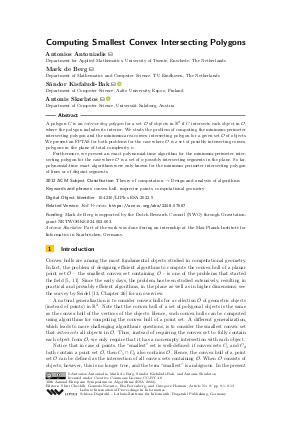Computing Smallest Convex Intersecting Polygons
Authors
Antonios Antoniadis,
Mark de Berg,
Sándor Kisfaludi-Bak  ,
Antonis Skarlatos
,
Antonis Skarlatos 
-
Part of:
Volume:
30th Annual European Symposium on Algorithms (ESA 2022)
Part of: Series: Leibniz International Proceedings in Informatics (LIPIcs)
Part of: Conference: European Symposium on Algorithms (ESA) - License:
 Creative Commons Attribution 4.0 International license
Creative Commons Attribution 4.0 International license
- Publication Date: 2022-09-01
File

PDF
LIPIcs.ESA.2022.9.pdf
- Filesize: 0.89 MB
- 13 pages
Document Identifiers
Related Versions
- Full Version https://arxiv.org/abs/2208.07567
Subject Classification
ACM Subject Classification
- Theory of computation → Design and analysis of algorithms
Keywords
- convex hull
- imprecise points
- computational geometry
Metrics
- Access Statistics
-
Total Accesses (updated on a weekly basis)
0PDF Downloads0Metadata Views
Abstract
A polygon C is an intersecting polygon for a set O of objects in ℝ² if C intersects each object in O, where the polygon includes its interior. We study the problem of computing the minimum-perimeter intersecting polygon and the minimum-area convex intersecting polygon for a given set O of objects. We present an FPTAS for both problems for the case where O is a set of possibly intersecting convex polygons in the plane of total complexity n. Furthermore, we present an exact polynomial-time algorithm for the minimum-perimeter intersecting polygon for the case where O is a set of n possibly intersecting segments in the plane. So far, polynomial-time exact algorithms were only known for the minimum perimeter intersecting polygon of lines or of disjoint segments.
Cite As Get BibTex
Antonios Antoniadis, Mark de Berg, Sándor Kisfaludi-Bak, and Antonis Skarlatos. Computing Smallest Convex Intersecting Polygons. In 30th Annual European Symposium on Algorithms (ESA 2022). Leibniz International Proceedings in Informatics (LIPIcs), Volume 244, pp. 9:1-9:13, Schloss Dagstuhl – Leibniz-Zentrum für Informatik (2022)
https://doi.org/10.4230/LIPIcs.ESA.2022.9
BibTex
@InProceedings{antoniadis_et_al:LIPIcs.ESA.2022.9,
author = {Antoniadis, Antonios and de Berg, Mark and Kisfaludi-Bak, S\'{a}ndor and Skarlatos, Antonis},
title = {{Computing Smallest Convex Intersecting Polygons}},
booktitle = {30th Annual European Symposium on Algorithms (ESA 2022)},
pages = {9:1--9:13},
series = {Leibniz International Proceedings in Informatics (LIPIcs)},
ISBN = {978-3-95977-247-1},
ISSN = {1868-8969},
year = {2022},
volume = {244},
editor = {Chechik, Shiri and Navarro, Gonzalo and Rotenberg, Eva and Herman, Grzegorz},
publisher = {Schloss Dagstuhl -- Leibniz-Zentrum f{\"u}r Informatik},
address = {Dagstuhl, Germany},
URL = {https://drops.dagstuhl.de/entities/document/10.4230/LIPIcs.ESA.2022.9},
URN = {urn:nbn:de:0030-drops-169470},
doi = {10.4230/LIPIcs.ESA.2022.9},
annote = {Keywords: convex hull, imprecise points, computational geometry}
}
Author Details
- Department for Applied Mathematics, University of Twente, Enschede, The Netherlands
Funding
Mark de Berg is supported by the Dutch Research Council (NWO) through Gravitation-grant NETWORKS-024.002.003.
- Skarlatos, Antonis: Part of the work was done during an internship at the Max Planck Institute for Informatics in Saarbrücken, Germany.
References
-
Antonios Antoniadis, Krzysztof Fleszar, Ruben Hoeksma, and Kevin Schewior. A PTAS for Euclidean TSP with hyperplane neighborhoods. ACM Trans. Algorithms, 16(3):38:1-38:16, 2020.

-
Moshe Dror, Alon Efrat, Anna Lubiw, and Joseph SB Mitchell. Touring a sequence of polygons. In STOC 2003: Proceedings of the thirty-fifth annual ACM symposium on Theory of computing, pages 473-482, 2003.

-
Adrian Dumitrescu. The traveling salesman problem for lines and rays in the plane. Discrete Mathematics, Algorithms and Applications, 4(04):1250044, 2012.

- Adrian Dumitrescu and Minghui Jiang. Minimum-perimeter intersecting polygons. Algorithmica, 63(3):602-615, 2012. URL: https://doi.org/10.1007/s00453-011-9516-3.
-
Ray A. Jarvis. On the identification of the convex hull of a finite set of points in the plane. Information processing letters, 2(1):18-21, 1973.

-
Ahmad Javad, Ali Mohades, Mansoor Davoodi, and Farnaz Sheikhi. Convex hull of imprecise points modeled by segments in the plane, 2010.

-
Yiyang Jia and Bo Jiang. The minimum perimeter convex hull of a given set of disjoint segments. In International Conference on Mechatronics and Intelligent Robotics, pages 308-318. Springer, 2017.

- Shunhua Jiang, Zhao Song, Omri Weinstein, and Hengjie Zhang. A faster algorithm for solving general lps. In STOC '21: 53rd Annual ACM SIGACT Symposium on Theory of Computing 2021, pages 823-832. ACM, 2021. URL: https://doi.org/10.1145/3406325.3451058.
- Marc J. van Kreveld and Maarten Löffler. Approximating largest convex hulls for imprecise points. J. Discrete Algorithms, 6(4):583-594, 2008. URL: https://doi.org/10.1016/j.jda.2008.04.002.
- Maarten Löffler and Marc J. van Kreveld. Largest and smallest convex hulls for imprecise points. Algorithmica, 56(2):235-269, 2010. URL: https://doi.org/10.1007/s00453-008-9174-2.
-
Franco P. Preparata and Se June Hong. Convex hulls of finite sets of points in two and three dimensions. Communications of the ACM, 20(2):87-93, 1977.

-
Xuehou Tan. The touring rays and related problems. Theoretical Computer Science, 2021.

-
Csaba D. Tóth, Joseph O'Rourke, and Jacob E Goodman. Handbook of discrete and computational geometry. CRC press, 2017.

